#british country style mansion
Explore tagged Tumblr posts
Text

Thanks to cuteaquarium for sending this gorgeous 1924 estate that's for sale in Seattle, WA. Modeled after a British Manor, the 6bds, 7ba, home is priced at $14.9M.

Wow, classy Seattle property. Look at the entrance doors and gardens.


Beautiful sitting room with doors to a patio with a view of Lake Washington and the Cascade Mountains.

Wet bar tucked discreetly in the wall.

This is definitely a man cave style place to relax with friends, or just with a good cigar or pipe, and a glass of dessert wine.

The dining room is cozy with upholstered chairs and a fireplace.

The kitchen is fabulous. Well-thought-out, not just pick a cabinet and have them installed. They chose beautiful white, timeless Shaker style cabinets featuring cupboards, china cabinets, glass doors, and closets. The only counter is on the large island. Isn't the wood beautiful? And, the quartz top is perfectly matched.

But, the focal point is the stove. They had it set into the wall to mimic an ancient cooking fireplace. Cabinets on both sides hold cooking utensils, the copper backsplash is gorgeous, and the pot filler tops it all off.

A statue stands on a plinth in the hall by the stairs.

The railing features variously carved balusters and the stairs are covered in leopard print carpet.


A spiral staircase wraps around this interesting, and very sturdy, column.


The only area of the primary bedroom they show is the set of double doors opening to a terrace with a stunning view.

One of the bath's has a marble tub in front of a window.

Beautiful home office. I like the brown paint on the coffered ceiling.

And, every estate must have a wine cellar.

The garden is a beautiful green frame for the lake and mountains.

No matter where you look there's a gorgeous view.

Closeup of the outside lantern details.

Sculptural architecture makes the home look old.


Thick textured balusters in the gated entrance.

A dining terrace.

Very elegant estate on a 9,021 sq ft lot.

Lit up at dusk.
https://www.zillow.com/homedetails/Seattle-WA-98112/349486709_zpid/
133 notes
·
View notes
Text
Moonstruck | 성훈 🖤 엔.하.이.픈 (。•̀ᴗ-)✧


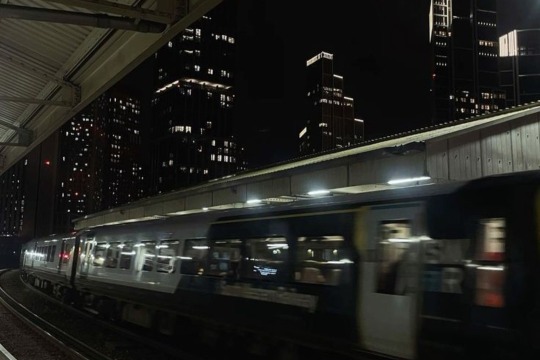
Paring: idol!Sunghoon X M!reader
Genre: Fluff. Synopsis: Taken a week vacation in the UK that Jay suggests to find out that, he's not the only child, he had another little brother?
Non proof read English is not my 1st.
This is a work of fanfiction, do not throw unnecessary tantrums on this nsfw/sfw blog. ©Shuenkio
A/N: Forget to mention m/n have the punk/hip-hop style in dressing, black from head to toe you can imagine ;) btw English here is a bit cheeky, hope you don't mind.

The World Tour comes to an end, the boy band group "ENHYPEN" gets a chance to take their own break, vacations and personal doing. It is a blessing and relief that they all get time to rest, after doing concerts non-stop, they're gonna spend time in their own way.
On the other hand, in the dorm, Jay, one of the members chit chatted with his teammates if they wanted to go on vacation in the UK. Positivity, they are all immediately drawn and agree to the suggestion idea. The boys had never stepped foot in the UK before, so why not ? Even better, Jay would pay half of the tickets too, isn't that Great? Only idiots can decline this offer.
After flying a few hours from Korea to the UK, it finally arrived. The land of the united kingdom, known as the British country. It's like entering another side of the world, people have their own unique remarkable, people speak British English, chaos and busy days, with the high technology here. This is gonna make one of the best memories ever.
Moving on to Jay's place. Actually it was one of his parents places here. After hearing Jay would bring his teammates in, his parents happily flying over the moon, quicker than the speed of light, arrive in the UK to prepare and welcome them, not to mention they have a private jet that's why.
Knocking on the tall well-built traditional door, all 7 guys greetings by Jay's parents, with a warm hug and kiss. While taking a peek inside, it is like taking a vacation in a damn golden castle. Everything is decorated in luxurious furniture, the light, the floor, and it's hella large, just imagine a mansion like.
Settled down inside, Both of Jay's parents went through the kitchen to prepare a lot of meals for the family, and the guests but that's not the case, they're all family too. Admire in the surroundings, Jay would be given them and show them their guest bedroom, and what to do and don't until most of them are in their own guest room, left Sunghoon who was there, standing alone like a lost puppy in his mate's house.
"Uh Jay-ah, where can I sleep for tonight?"
"...hmmm.. all the guest rooms are full now for them so maybe my brother's room, come on let me show you, I hope he won't be mad"
Sunghoon blinks, furrow his brows confused as Jay mentioned he just has a brother knowing all along he is the only one, when he said that, it makes no sense.
"brother? ... You had a brother? I thought you were the only child?" Said while walking, as Jay guided him to M/N room.
"it's a long story, I didn't tell you all for a reason, haha now now we're here" Knocking on the door, Jay speaks calling, for M/N name. Later, the door opened, revealing a boy who was dressed, in a very... Different style, that quickly grabs Sunghoon's attention.
"JAY?" You happily shout, knowing Jay home after waiting for him for days, greeting him with a hug, which is soon returned by him.
"M/N! How I miss you. How are you? Are you doing great?"
"well yeah I am, I'm very good and I hope you're doing okay too" You respond, crossing your hands in. Then your eyes land on a taller pale guy, behind Jay. You might know him, but he probably doesn't.
"oh, is he Sunghoon hyung?" Mutter, you peeking behind your brother's back, to see clearly. Sunghoon who was an introvert guy, feeling and surprised that you know his name, mixed with awkwardness in this kind of situation, especially with strangers, but does he have to get used to it? It's Jay's brother after all.
"you know a lot don't you? Yeah He's the Park Sunghoon that you like the most" like the most? Sunghoon's face turning tomatoes, as he is puzzling. feeling like his heart Sprint away from his own beat, so you do like him? Well when fans confess they like Sunghoon, it's just a normal reaction but when He knows you like him, it's weird, different feel from those fans. or maybe he is just shy ? Or super shy?
"Hi! Sunghoon hyung it was nice to meet you, I'm M/N" bowing down in a respectful way, you suddenly switch language once you greet him, which once again makes Sunghoon feel dumb like a lost sheep. There's so much information going on here.
"O-oh yes... M/n... Good to see you. Your Korean is nice I'm Impressed" Sunghoon greet back, feeling more used to and ease once you speak to him in Korean. After all those greetings, Sunghoon just stood there, didn't know what to do next as he watched Jay and You, asking about their days.
"oh right, Sunghoon you must be wondering. Actually he was my adopted brother. We had him when I was pre-teen. But I understand most of you guys don't know about him because we like to gatekeeping him Haha well today all the members would know, don't worry—
He is half asian and europe also, that is why he has a unique style, from his head to toe isn't it cool haha. Punk style but you'll get used to it, I know ni-ki is gonna love him—
Okay I talk too much, so M/n mind if I borrow your room for a few days? For Sunghoon? All the guest rooms are full, can he stay with you" Jay state, after the small talk. Meanwhile, M/n agree to his brother request, not that he was a creep, it because of the situation, also who wouldn't? It was the Park Sunghoon.
"Sure, hyung can sleep in my room. I'm all good"
"Thanks bud, now Sunghoon? You can settle in here— oh right... Sunghoon?" Jay called, Sunghoon catches himself zooming out to your appearance, it not everyday to see someone looking good in such style, black from head to toes. Seeing such reactions makes you chuckle, as Sunghoon snapped out, ashamed with a blushing red face before getting inside to load away his stuff.
"Right, Right I hope you don't mind me M/n"
"I should say that, hehe since you're the guest, just asked me don't be shy, I'll do it"
"Thank you ha" seeing the two of you getting along well, Jay's warm smile appears as he leaves the room, and gone downstairs.
-///-
In the rest of the evening all the boys and family, get to know you better, as you introduce yourself as Jay's adopted little brother. Jay was right when he said You'd be ni-ki favorite, because once he saw you, he imma befriended you. Exchange the number, ask about your Style, and talk for hours about stuff ni-ki wanted to know. While the other member was also surprised when they realized that Jay was keeping you well in the basement for the whole time and none of them knew about it. It can also be reasonable because of that gorgeous handsome face you got there, that catches every member's attention.
Jake would ask you to chat with him in English as he wanted to learn how to talk in British too, and so is Heeseung. Your accent makes their knee weaken with that soft tone of yours.
Jungwon would also be talking to you too, asking this or that and often joking about your brother why he is a comedian in the group. Sunoo would compliment your skin tone, the skin you got on your face stunned him in a way that he can't help, but to ask what's your skin care routine.
But for Sunghoon, He just laughed and giggled along, when the members asked or talked to you. He was so shy and afraid to make conversation with, and he had nothing to talk about. He was devastated to get to know you well just like the other but then it clicks when he learns that he'll spend every night sleeping on the same bed with you.
Yet that's fine. On the first night, you asked him if he wanted to sleep on the bed alone, if he was a light sleeper you can move to the couch but Sunghoon insisted, both of them should be on the bed. He was the guest anyway he didn't want to burden anybody.
And so on, Sunghoon got a more private chance than others when it comes to talking, especially at night when it's just the two of you. Most of the time, all night he would ask this and that, and do you have a girlfriend or boyfriend, about your life and personal thing which you happily respond to. Sunghoon was your bias of course, you would tell him everything, admire his million dollar face while you talk so, people would fight for him.
As the days passed on about a week. It's time for all the 7 members to go back to Korea. You help them pack their stuff, and so do your parents and Jay. The past few days, they are spending time with you by talking, going out, shopping and the Disney land date, it was such a good snapshot in time to get to know them all better. Before they leave you give each of them a promising and memories gift to remember this precious time together, the boys happily satisfied accepted and their heart melting to the gesture. You were so sweet.
However, for Sunghoon it was different. Even though it's just a simple gift he clearly enjoys more than the rest, and he promised he will cherish this gift for a long time.
"Thank you m/n letting me stay in your room, you're so... Cool and nice, sweet, like Jay. Here, I have my PC card haha I know it's not much but I hope you like it" gasp, you feel like you're about to ascend up to heaven as Sunghoon gives you back a gift, a rare PC card that you wised to have.
"oh my GOSH thank you hyung, I love it so much thank you woah it's sighed? I'm going to be crazy!!"
Laughing. Everyone finds the moment cute and adorable as you express yourself as a fan. Soon the time will come, you wave goodbye to the seven guys as you watch them disappear in the plane.
"Good luck hyung!! See you sometime later"
"yess" they all said in unison, enter the aircraft with a warming heart. On the way, Sunghoon can't help but to say it out loud.
"I like him, Jay"
"ehhh"
"No Sunghoon hyung, I like him first he was my buddy!" Ni-ki argue.
"ey ey ey he was my British guy before all of you guys, he was my first" Jake burst in playfully.
"but I do really like him, in a way"
"...."
"well— what "

#enhypen#enha x male reader#enhypen x male reader#sunghoon fluff#sunghoon x reader#park sunghoon#sunghoon#sunghoon scenarios#enhypen sunghoon#enha sunghoon#enha imagines#enha x you#enha fluff#enhypen scenarios#kpop x male reader#enha x reader#enha scenarios#enha fanfic#enhypen fanfiction#enhypen fluff
172 notes
·
View notes
Text



Barrington Hall
Hi guys!!
I'm sharing Barrington Hall. This is the 21st building for my English Collection and inaugurating the red brick collection.
I decorated most of the house ground floor, for reference.
History of the house:
The Barrington family, long-established in Essex since the Conquest, initially resided at Old Barrington Hall. This estate, shown on a 1624 map, included substantial structures, orchards, fish ponds, and brickyards. However, in 1564, they moved to the Priory at Hatfield Broad Oak, signaling their ascent as country gentry. Throughout the late 16th and early 17th centuries, the family engaged in legal disputes over rights to Hatfield Forest with the Rich family, eventually securing a portion of the forest.
Sir Francis Barrington played a significant role in government, receiving a baronetcy in 1622. The family also had investments in New England and Ireland during this period. Despite their growing wealth, the Priory required repairs by 1700 and was demolished, causing the Barringtons to relocate to Great Waltham. The family seat at Hatfield Broad Oak was eventually rebuilt in the 1730s by John Shales Barrington, although he left it unfinished, leading to his reclusive life.
In the 19th century, George Alan Clayton Lowndes acquired the estate and made extensive neo-Jacobean renovations to the house and gardens, which were lauded in contemporary publications. After multiple ownership changes, including the purchase by A.H. Gosling in 1907, the property was later sold to the British Livestock Company and is now owned by CPL Aromas plc. The original parkland has been divided, with only 12 hectares surrounding the house remaining as part of the current estate. The landscape includes notable trees such as ancient oaks, as well as remnants of historic avenues and garden features.
More history: https://www.francisyork.com/blog/barrington-hall-a-palatial-georgian-mansion-one-hour-from-london














House file:
Location: Essex, England
Material: red brick
Style: Neo-Jacobean
Date: 1624 + remodelings
This house fits a 50x50 lot, but it coulf fit a 50x40 if you lose the garden.




I only decorated some of the important rooms. All the rest of the house is up to your taste to decor.
Hope you like it.
You will need the usual CC I use:
all Felixandre cc
all The Jim
SYB
Anachrosims
Regal Sims
King Falcon railing
The Golden Sanctuary
Cliffou
Dndr recolors
Harrie cc
Tuds
Lili's palace cc
Please enjoy, comment if you like the house and share pictures of your game!
Follow me on IG: https://www.instagram.com/sims4palaces/
@sims4palaces
Ealry acces: November 20
DOWNLOAD: https://www.patreon.com/posts/barrington-hall-113325949
#sims 4 architecture#sims 4 build#sims4#sims 4 screenshots#sims4building#sims 4 historical#sims4play#sims4palace#sims 4 royalty#ts4#ts4 download#ts4 screenshots#ts4 simblr#ts4 gameplay#the sims 4#sims 4#simblr#sims4 build#sims 4 gameplay#thesims4#sims 4 cc
44 notes
·
View notes
Text
Doyle makes the kind of mistake that faithful readers send letters about in chapter IV of The Valley of Fear, the most recent Letters from Watson in my in-box.
At the end of the chapter, the big news is that a bicycle has been found that might belong to the killer.
It was a well used Rudge-Whitworth, splashed as from a considerable journey. There was a saddlebag with spanner and oilcan, but no clue as to the owner.
Rudge-Whitworth was a real brand... that originated from a merger in 1894. In the late 1880s, the cycle would have been a Rudge or a Whitworth, but not both. My sympathy is completely with Doyle on this one, as I've been trying just this past week to reconcile memories of the early/mid-1990s with verifiable dates of historic events.

As far as the Pennsylvania Small Arms Company, consensus is that it's fictional.
Meanwhile, I was distracted by the description of the murder mansion as Jacobean (1603-1714) and started wondering if the American victim actually lived in a 200-year-old home -- or in a newer exurban build in a revival style.
There was a Jacobean Revival in the UK (spreading to the US, Canada, and other former and then-current British possessions), starting around 1830! It continued all the way into the 1920s, which is why there are so many official buildings with liver-colored or yellow brick, big flat front gables, and those nice many-paned sets of windows.

Since I'm having to squint to read the text in the helpful handout, above, from Old Home Living, I'll summarize:
Stone or brick
Cement window trim and casement windows
Steep roofs finished with slate
Prominent chimneys
Often semi-hexagonal bays with parapets
The Jacobean Revival style (now often called Jacobethan, since it has merged with Elizabethan/Tudor Revival) hearkened to an ideal of Merrie Olde England, with everyone wearing ruffs, eating roast beast, and watching Shakespeare plays.
If you check RightMove in East Grinstead, there are new homes being built with Jacobethan facades even now.
The presence of a moat says nothing for the murder mansion's authenticity, since follies like moats were exactly what wealthy exurbanites would adore. So my headcanon for the moment is that our victim is a wealthy American parvenue who wants to play country squire but positively has no roots in that world.
Perhaps next time, we shall learn what Holmes' "gleam of light" in this case might be. Since all the assorted detectives and doctors are discoursing with supreme rationality, I believe everyone, and they're likely all wrong.
13 notes
·
View notes
Text
An immortal companion.
The Suckening Fanfic :3!!
- Arthur & Void’s meeting
⚠️⚠️TW’s!!⚠️⚠️
- The Suckening SPOILERS!!
- blood
- mention of dead people
- deceased family
- biting
- british people……….😰😰
Britain. London to be specific. The city was quietly heading to sleep. Tourists back in their hostals for the night. Locals out wondering with their lover in arm. Walking a dog. Or going for a midnight run. Headed twards the homes in town. Arthur’s stomach screamed at him for food. Knowing he would need too feast eventually. A beautiful home on the other side of the bridge perks Arthur’s interests. He stops himself from heading inside. Instead going to the home we’re focusing on. A group of crows fly past Big Ben and down the bridge towards the country side. Large mansions scatter the fields. Deep thick forests as their privacy. And or for their secrets. A large country style home. Far off, away from the city. The furthest from London. Abandoned and wasted away by age. A home filled with happiness converted into chaos. Free from the pain the vampires gave to them, Vanya created that chaos. Arthur guided it. Opening the door to chaos. Falling in love with a murderer. Becoming the murderer. And soon enough ending his own killer.
The doors and windows all shattered the home spray painted ruined by the locals. A for sale sign in the grown out grass outside. A large sticker covering up most of the sign saying ‘Sold’.
Arthur walks twards the home. Down the abandoned street. Watching the other full homes erupt with happiness and joy. Dreading it. Dreading seeing the home his father had built. The family he had. And the home he destroyed. Saying goodbye to them would be the last thing he did tonight. The beatiful home crushed and crumbled as he walks by into the distant forest. The screams that echoed through that home loudly bang in his skull as he steps in the same path as he did once before. Following his old foot steps. Flashes of his hands covered in blood rather than ink. His clothes damp with his mothers blood. Her face looking horrified after being brutally mauled from her oldest son. Soon needing to head back to the home to drag the twins to their new home. Arthur’s eyes slowly watered up. Rememeber the twins. The horror of their faces. He wiped them away and pushes his glasses closer to his eyes. Pulling his jacket closer to himself. Hiding him in more shadow.
Eventually, getting to a empty slot of the forest. With small round rocks identifying the graves.
His brother, Mikey.
His sister, Emily.
His Mother, Danielle.
His Father, Micheal.
and one for himself. Arthur Bennett. The murderer.
He stands infront of the graves. Watching them. His young, rushed handwriting showing the initials. Some of the blood had dripped off his clothes marking the rocks. His permit handprint. Showing off what he had done.
Arthur takes his glasses off, slowly. His tears were retreating back into his eyes comes back. As he opened his mouth to begin talking. A rustle in the bushes startles him. He slowly raises his hands above his head. The bush continues to shake. Arthur annoyed replies to no one specifying. “I can hear you.” the rustling stops than hearing a “mreoww?” before seeing a fluffy creature jump out and begin rubbing on his ankle. His fancy black shoes covered in wet, damp mud. Seeing a black cat with glowing white eyes looking back up to him. The beast within grows.. bending down. Looking very calmly at the cat. Arthur sighs. “get away, cat.” he uses his mud covered shoe to push the cat. Making her fall over to her side. Still just staring at him. Rolling over to her stomach. “I don’t want to get you killed too.” he states. More angered than before. Pointing his finger towards the home. “Meowww!!” This time while she meows. Rubbing his eyes. “What a pain.” He utters to himself before watching her mouth open and shut. Her sharp teeth. Not like teeth matching his own. Regular cat teeth. He pulls back from the cat but continues to stare at her before breaking eye contact. Continuing to stare at grass that had grown over the dug up dirt from that night. Squatting down, resting his elbows on his knees. Further from the cat than before.
“Hello Mother..Emily..Mikey.. father.” He whispers saying ‘Father’ as if scared to talk to him. While looking at each individual grave. Pressing his hand on the blood stain. Minus his fathers. He respected his father. But.. cutting off his own thought he turned to his mother’s grave. “I will find her mother. I will fix this.” Placing his hand back onto the rock with his bloody hand below.
“mreow?” The cat stood up and began rubbing its head on Arthur’s knee. His eyes water again. His jacket still closed in on himself. The cat jumps on his leg. Using her claws to go up on his shoulders. Arthur screams “can’t you see I’m doing something!?” His voice shaky but tryin to keep his composure. Tears begin to fall despite that. The cat stops on his right shoulder. Sitting down and looking at him. The cats head bangs into Arthur’s ear. He can hear the cat is purring now. Practically vibrating with comfort. Arthur hasn’t felt this comfortable since he was young.
His mother’s warm embrace. His younger siblings soft and innocent hands holding his to cross the street to walk them to school. His father patting him on the shoulder.
This cat giving him the same comfort tears begin to fall. His body begins to shake. Being loved by a creature that doesn’t want to end him. A creature that comforts him. Unknowing of what he has done. The dirt beneath his feet begins to wet. His glasses falling off into the mud. Making a splat before coloring his striped pants brown. His hands go through his hair. Tears flowing out of his eyes. Just like what happened before. He bawled in the wet mud like a child. She rubs against him as he pets her more. His stomach growls louder the closer she gets to him. His hands move on their own. Grabbing the cat. Making her arms dangle. Her head tilts. And meows. Revealing her neck even more. The beast growls and grows. His mind screaming at him to feast. To finally fill the beasts needs. To free this cat from the world. Give her a reason to get far away from him.
“I need you, cat.” She begins to squirm and fight back. Revealing her teeth once more and biting his hand.
He bites her back. Digging his teeth into the cat. She stops wiggling. The comfort of the bite from both parties hypnotized them. Vampirizing the cat to cure both of their loneliness.
2 immortal companions. He released himself from the cats neck and stares at her. The cat looks loopy. Like she’s getting off of anesthesia. “Void.” He growls, his hands become more and more inky as the cat jumps off of him and sits in the mud. Still staring at him. He kneels down to apologize. But before he can speak the cat licks the bite from his hand before crawling on his neck once more. Arthur slowly stands up not to disturb her as she began purring once more. Accepting his new companion. He sighs and scratches her chin. “Apologies, cat.” His feet sinking into the mud more. Grabbing his glasses from the floor. Looking back to Void seeing she had fallen asleep in his shoulder. His mouth slowly moves upward before falling back down into his brooding glare. 
Placing his hands back into his pockets. He pulls his jacket’s collar upwards to hide Void within the shadows. He shakes his glasses to get the mud off. Before placing them on his nose. Turning his back to the graves. Placing his hand on a tree near the bush Void came out from. Glaring as he looks down at his father. “Goodnight, father.”
walking the same way, to go retrieve the twins.
⭐️sighhh I love my depressed vampires,,,,
⭐️I’m probably going to write more about him cause I love Arthur :3!!
#jrwi#jrwi show#jrwi the suckening#the Suckening fanfic#writing#jrwi arthur#arthur bennett#vampire silly!!#<3#hungry#fanfic for fun :3#eating this shit up#beastmode
13 notes
·
View notes
Text
Top 10 British Horror Movies

British horror cinema has a rich history, producing some of the most iconic and terrifying films that have left a lasting impact on the genre. Here are the top ten British horror movies, showcasing the diversity and excellence of British horror filmmaking:
1. Don't Look Now (1973) - Nicolas Roeg's psychological chiller is a masterclass in atmospheric tension, exploring grief and obsession in a haunting tale set in Venice.
2. The Descent (2005) - Neil Marshall's claustrophobic horror follows a group of women trapped in caves, hunted by subterranean creatures, delivering a tense and terrifying experience.
3. Shaun of the Dead (2004) - Edgar Wright's zombie romp is a hilarious blend of horror and comedy, starring Simon Pegg and Nick Frost as two friends trying to survive a zombie apocalypse in London[4].
4. The Wicker Man (1973) - Robin Hardy's cult classic is a slow-burning, atmospheric horror that explores paganism and sacrifice on a remote Scottish island, starring Christopher Lee.
5. Kill List (2011) - Ben Wheatley's dark and unsettling film follows a hitman who takes on a mysterious job, descending into a world of horror and the supernatural.
6. The Haunting (1963) - Robert Wise's adaptation of Shirley Jackson's novel is a classic haunted house story, featuring a group of people invited to a mansion with a dark history.
7. Saint Maud (2019) - Rose Glass's critically acclaimed film tells the story of a devout nurse who becomes obsessed with saving the soul of her dying patient, blurring the lines between faith and madness.
8. Dog Soldiers (2002) - Neil Marshall's werewolf horror follows a group of soldiers who find themselves under attack by the creatures while on a training exercise in the Scottish Highlands.
9. The Innocents (1961) - Jack Clayton's adaptation of Henry James' "The Turn of the Screw" is a gothic horror classic, featuring a governess who begins to suspect that the children in her care are being haunted by malevolent spirits.
10. Prevenge (2016) - Alice Lowe's film follows a pregnant woman who is convinced that her unborn child is urging her to kill, exploring themes of grief, trauma, and the supernatural.
These films represent some of the best of British horror, showcasing a range of styles, themes, and eras that have contributed to the country's rich horror heritage.
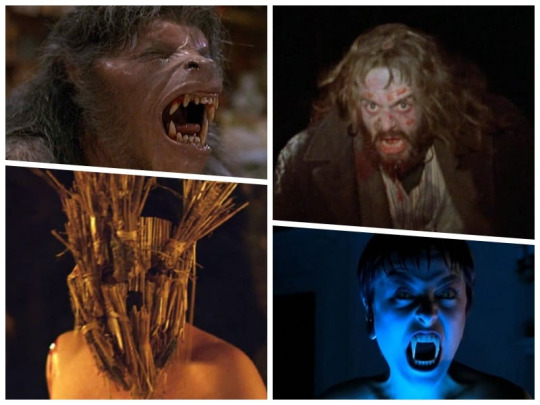
4 notes
·
View notes
Text
Buenos Aires, Argentina. Dec. 17-19, 2024

Nancy and I flew to Buenos Aires (BA) Argentina a few days before our Antarctic Expedition. We flew on the red eye from Miami direct. Nancy made reservations at a great hotel, Claridge Hotel (circa 1946), walking distance to the historic downtown. After checking in early we roamed the streets getting a lay of the land. The next two days we did a walking tour of the city.
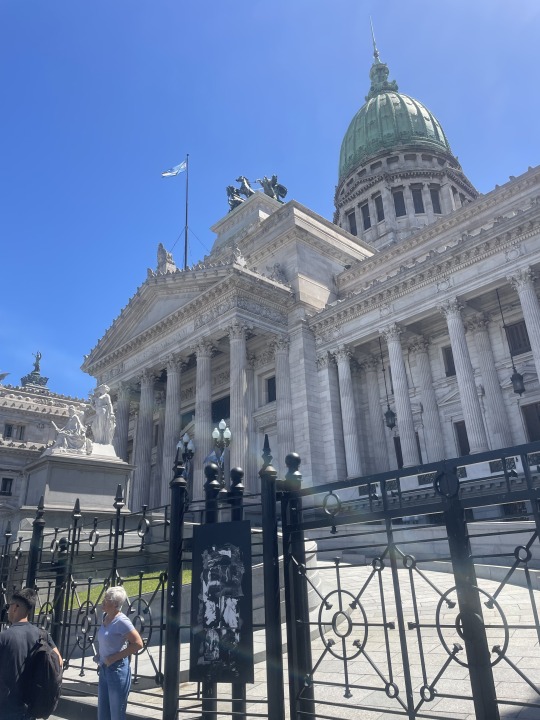
We met our first guide at the Congress Building. So many countries, Argentina included, had adopted the US style of two houses of Congress.
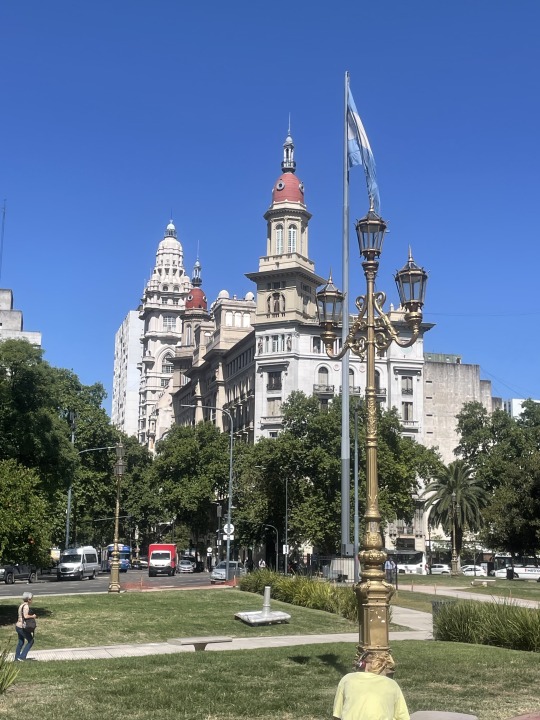
The city is full of beautiful architecture dating back to its hay day of great economic wealth. The emigrants wanted to show how well they had succeeded, and mimicked the best that Europe had done.
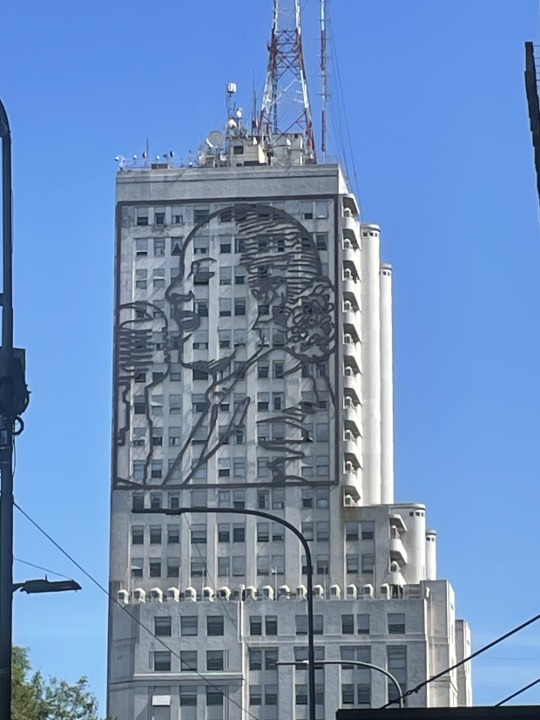
This is a homage to the famous Evita Paron. Here she is talking into a microphone and not about to eat a hamburger. She was the first lady of Argentina from 1946 to 1952. People loved her. But either loved or hated her husband.
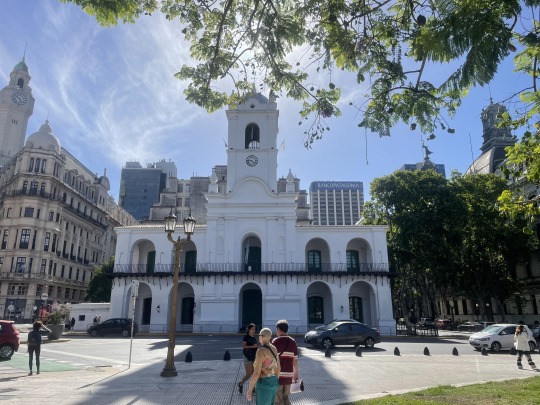
BA city planners leveled entire blocks to produce large Boulevards through town. It makes a beautiful city today but certainly impacted many people when they did. The building above is where the original colonial group met to declare Argentina county. It too was partially torn down to make way for the center boulevard. Originally it had 11 arches.
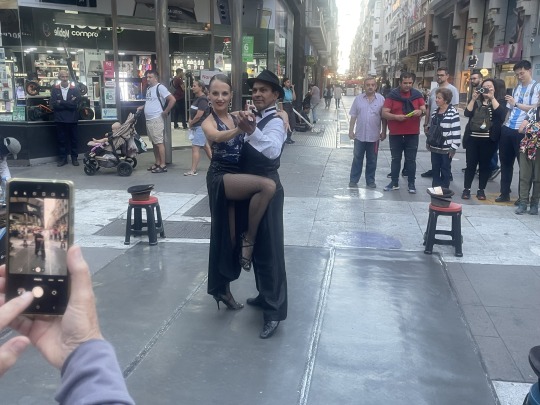
Argentina is famous for its dance, “The Tango.” We came across these two professional dancers working the street for tips. There are several dinner shows available at night.
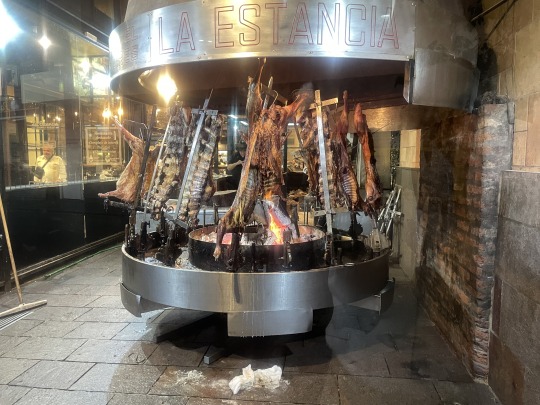
Argentina is also famous for its great meat. We ate at this restaurant where they put hot coals in a pot and bring it to your table with a variety of meats and sausages still cooking on it. Some call this meal “Death by meat.” We were stuffed and yearning anything green afterwards.
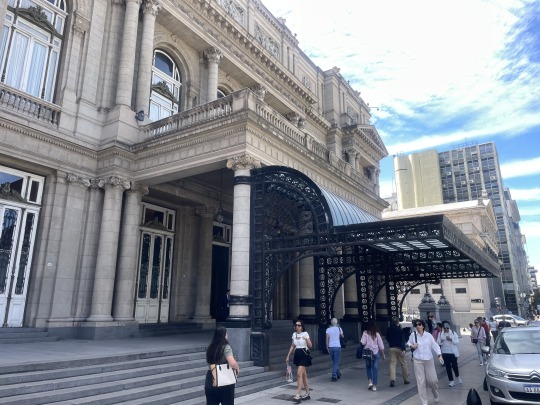
Day two, we met our second guide at the Opera building and did a long walk to the cemetery. Beautiful day not a cloud in the sky. These guides are very knowledgeable and passionate about their country. And also honest about petty crime and runaway inflation.
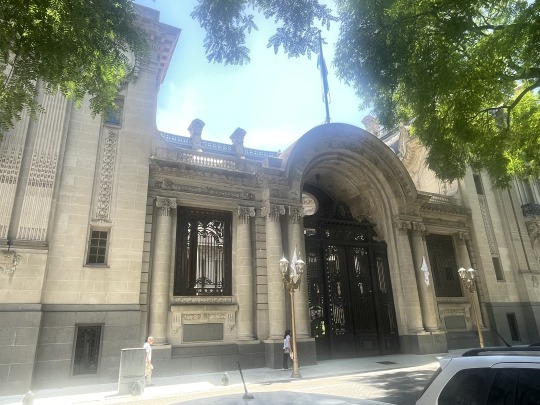
We passed huge mansions showing off the wealth and egos of their prior owners. There was a lot of showing off in the day.
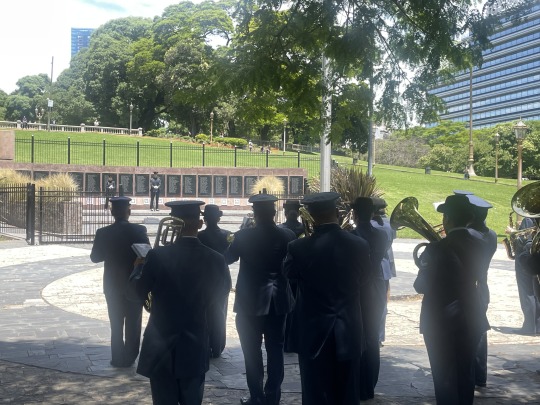
This was the Argentina Navy Band playing at a memorial to service members killed in the 1982 invasion of the Falkland Islands. 649 Argentines lost their lives, compared to 255 British servicemen. Argentina still claims the Isla Malvinas as theirs. Argentina and Chile do not like each other either.

Our tour ended at the gate to the cemetery. We took a break for lunch then joined our second tour for the day.
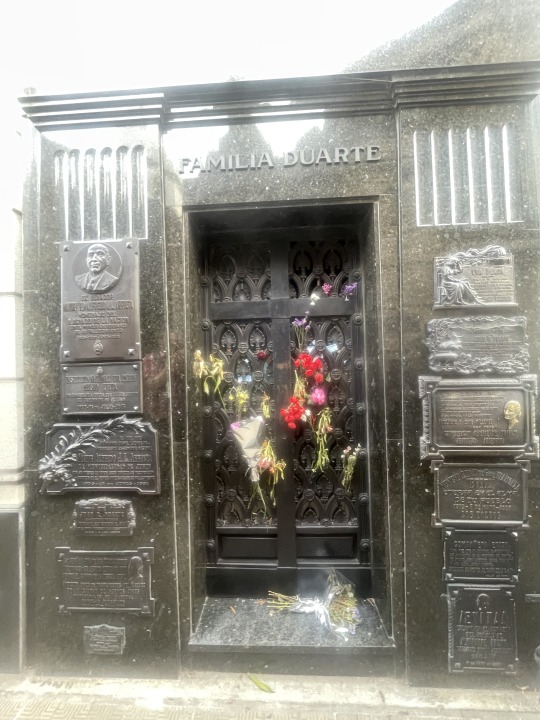
At the end of a great 2 hour tour of the cemetery we saw the famous grave of Evita. For a really bizarre story, look up the travels of Evita Peron after her death.

This chart shows the inflation in Argentina over the last year. In April it was at an all time high of 289%. Basically knock three zeros off of the peso cost of an item to convert to US dollars. A 3,000 peso empanada cost $3 US. It goes up daily so you only cash US dollars that you need for the day. It takes a fist full of pesos to buy anything. Money changers are every 100 feet on certain roads, singing out their trade.

Life is tough here now. The guides had said petty crime is up, people are rummaging through garbage cans. Which we witnessed multiple times.

Protest happen daily in the Capital city of Argentina. They are well established, news media, paddy wagons (buses) and ambulances are standing by. Police have some heavy duty crowd control vehicles right around the corner if things turn ugly. All monuments and statues have large unsightly fences around them. This demonstration is about inflation and economics.
We saw several graffiti symbols of old protest concerning the “Mothers of Plaza de Mayo.” Protesting the disappearance of 30,000 children during the Dirty War of 1976-1983. They no longer hold their weekly protest, but the white scarf symbols are still seen around the Capital.

This is one of several police vehicles we saw with a water cannon on top and an ugly looking blade in front.
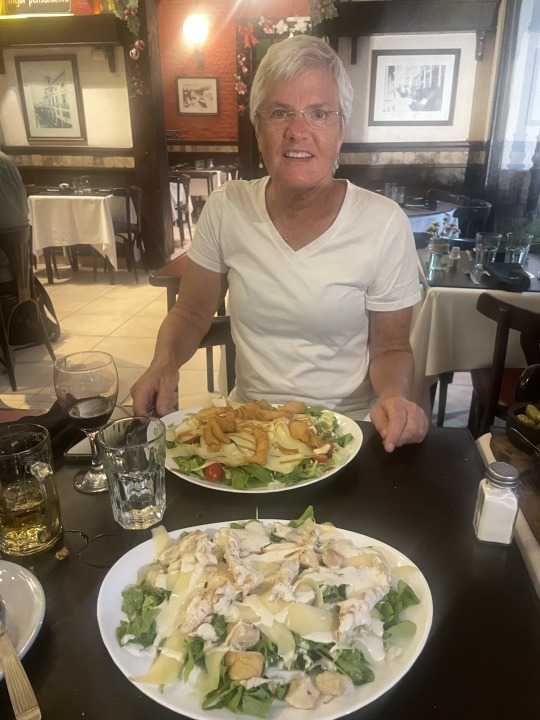
Second night in town we had a much more enjoyable dinner with salads at the Italian restaurant next door. Dinner was great, portions were huge. We had enough left over that the homeless guy outside the front door benefited greatly.
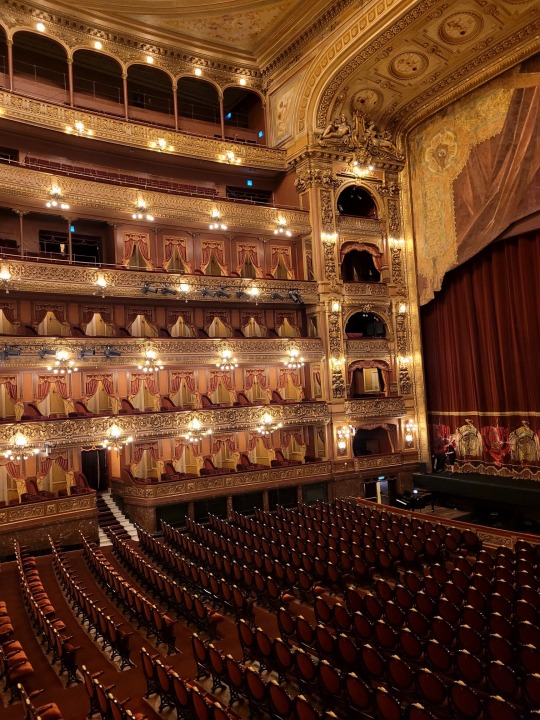
Day three we did the opera house tour. This was a real treat. Completed in 1908 it seats 2,478 people. They brag about how perfect the acoustics are in the building. Every seat at floor level and the box above receive perfect sound.
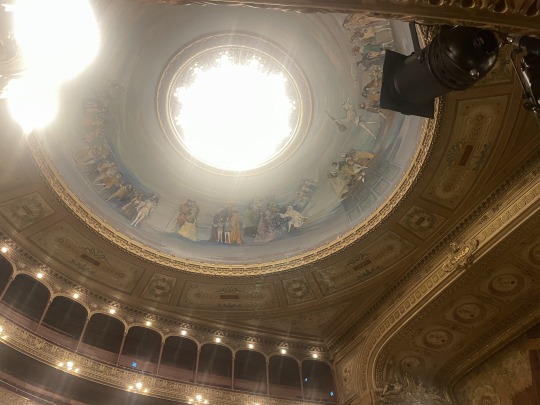
In the ceiling is a 2 ton light fixture. When required a choir of singers stand above the light and sing. Bringing the sounds of heaven alive. Realize this was built before air conditioning.
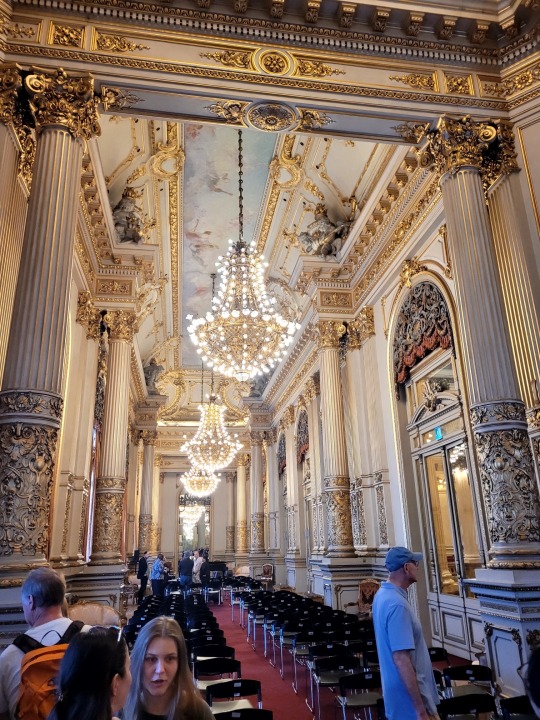
What a beautiful opera house. Again the best of Europe was brought over to build it. Money was no object.
We enjoyed our three days in Buenos Aires, and would encourage others to visit. Wouldn’t suggest venturing far at night.
In the afternoon we changed to the Hilton and checked in for our cruise the next morning.
0 notes
Note
I don't think Harry and Meghan are flops in regards to what they wanted to achieve though. The British press know fuck all about them and their comings and goings, we don't know what their kids look like the past 3 years, they pop up to galas when they want and look good when they do, they bought a house in Europe recently but not great Brittain (can't remember the country) and the papers were mad because they didn't know they'd been visiting or looking lol but it means they don't have to go to the UK to see his family and friends, they can visit them after a 1 hour plane trip. The podcast was pretty shit imo, I hated the cut ins and would rather a straight conversation but that's just my style, it wasn't renewed but it was still huge. And spare was the highest selling book the year it came out. The shit Meghan wears sells out as soon as pics drop, and the stuff she puts her name to sells quickly - I figure the weird announcement of ARO was more to prevent other people breaking the news first and developing a conspiracy around it all.
Idk I just personally think they're loving their best life as rich people who escaped an abusive family and after the abuse from the media - I don't think they want to court it. I'd 100% do what they do - I'm assuming they invested money to have a passive income of sorts, or things they can liquify as needed - but I'd be very happy to have a big ass mansion, be a SAHM with no money issues and growing flowers with the kids, doing shit when I felt like it but acting like I'm retired - fuck yes! Sign me up!
People were eager to cast Meghan in her first acting gig post royal life but she has taken it, maybe they're still working out what they want to do? But I think them not being big is more their choice than a failed attempt.
But I also don't like the institutional monarchy and loathe the British press, so anything that annoys either of them makes my heart glow with joy 🥰🤣
I just don’t know what their plan is? Also I’m 100% comfortable with “nothing” and they’re just gonna vibe but like they’re not seeming like that’s the plan? So it’s the disconnect between what they’re achieving (nothing) and their plan (I would assume something based on how active they are) for me??
0 notes
Text
Festive Travel Planning with JCR

As the leaves start to turn and the air gets a bit crisper, it's hard not to feel a sense of excitement for the upcoming holiday season. By October, holiday travel planning is officially in swing, a time when I'm personally filled with the anticipation of creating beautiful memories with loved ones. We'll be featuring resorts and destinations with festive celebrations that have left a lasting impact on me, ensuring your clients can make the most of the holiday season away from home. It's never too early to start spreading holiday cheer, and we’re thrilled to assist you in planning unforgettable holiday experiences that your clients will treasure for years to come.
Hotel Le Toiny St. Barth Hotel Le Toiny offers your clients a private retreat. With exclusive villas, a beach club, and stunning ocean views, your clients will experience the ultimate winter escape. Paired with festive celebrations, Le Toiny promises an unforgettable getaway.
St. Barth Connection St. Barth & Anguilla
St. Barth Connection is your go-to partner for a getaway in St. Barth or Anguilla. The team handles everything from exclusive accommodations and event planning to creating personalized itineraries filled with unique activities and seamless travel logistics.
Oil Nut Bay British Virgin Islands
This holiday season, treat your clients to Oil Nut Bay for a luxurious getaway featuring rum tastings, happy hour karaoke, and family-friendly fun like sandcastle competitions. With themed dinners and festive menus, it’s the perfect holiday escape.

Castlemartyr Resort Ireland
Celebrate the New Year in opulent style at Castlemartyr Resort in Cork, an estate where history and luxury blend seamlessly. With limited availability for their New Year’s Eve celebration, your clients will enjoy a festive evening in the grandeur of Castlemartyr’s 17th-century manor house.
Sheen Falls Lodge Ireland Sheen Falls Lodge offers a magical holiday escape in Ireland. Celebrate with festive meals and seasonal activities, from the annual Lodge Treasure Hunt to traditional Irish music. Your clients can enjoy the warmth of roaring fires, explore the estate’s scenic walking trails, or partake in exclusive experiences.
Ballyfin Ireland
Ring in the New Year in opulent style at Ballyfin, Ireland’s most lavish Regency mansion. Limited availability remains for their exclusive New Year’s Eve celebration, where your clients will enjoy a refined blend of Irish tradition, gourmet dining, and the magical charm of a historic country house.
Family Twist Europe
Make this holiday season unforgettable with Family Twist’s bespoke family experiences in Paris, Rome, Amsterdam, and London. From festive walking tours to hands-on cooking classes, Family Twist offers unique, immersive activities that capture the magic of the holidays in Europe’s most iconic cities, creating treasured memories your clients will cherish for years to come.
Esprit Saint Germain Paris, France
Spend a cozy holiday in Paris at Esprit Saint Germain. With exclusive 3- and 5-night packages, your clients can enjoy an intimate and luxurious stay, with close proximity to Paris’s seasonal attractions. Whether it’s exploring the city’s holiday markets or simply relaxing in the hotel’s warm ambiance, Esprit Saint Germain is the perfect retreat for a memorable holiday experience.

Almae Collection France and Italy Armancette Hotel offers a magical winter wonderland perfect for holiday escapes. With direct access to world-class skiing and breathtaking views of Mont Blanc, your clients can enjoy an active day on the slopes before unwinding in luxurious accommodations. From cozy evenings by the fire to indulgent spa treatments, Armancette creates an intimate, unforgettable winter retreat.
Katikies Resorts Santorini & Mykonos, Greece
Katikies Resorts are offering a limited-time promotion, perfect for either a last-minute getaway or planning ahead for a dream 2025 escape. With 15% off, personalized concierge services, and thoughtful welcome gifts like a bottle of wine and fresh fruits, your clients can indulge in an unforgettable stay in one of Greece's most stunning destinations.
OAG Greece Greece
Get a head start on planning your clients' Greek getaway for 2025 with OAG Greece, your trusted partner for exclusive, off-the-beaten-path experiences. Whether it's securing private villas, booking luxury yachts, or curating hidden-gem itineraries, now is the perfect time to lock in next season’s adventures while Greece quietly winds down from its 2024 season.
HL Adventure Iceland & Norway Celebrate the festive season with HL Adventure, where your clients can enjoy local traditions. Visit the Jólabasar við Mývatn Christmas market for handcrafted Icelandic goods and traditional treats like kleina or experience the charm of the 13 mischievous Yule Lads. From Northern Lights to cultural festivities, Iceland offers a holiday escape filled with warmth and wonder.
Grantley Hall United Kingdom
Grantley Hall offers an enchanting escape for the festive season, where luxury meets celebration in the heart of Yorkshire. With their exclusive holiday packages, your clients can enjoy festive dinners, sparkling lights, and a cozy ambiance that perfectly complements the holiday spirit.
Thyme United Kingdom
This holiday season, Thyme in the Cotswolds offers a variety of festive events, from wreath-making workshops to Christmas pudding classes. Your clients can fully embrace the traditions of the English countryside while creating beautiful memories for the holidays.
Glenapp Castle Scotland Escape to Glenapp Castle this New Year’s Eve, where a three-night festive retreat offers your clients the chance to relax and celebrate in Scotland’s serene countryside. From intimate gatherings to luxurious indulgence, Glenapp promises a New Year to remember.
Soneva Resorts Maldives & Thailand From events with Michelin-starred chefs to visits with Santa, Soneva offers a magical holiday getaway like no other. Whether it’s a relaxing escape or an adventure-filled holiday, Soneva’s unique blend of luxury and sustainability creates an unparalleled festive experience.
Elysium Lodge New Zealand
For a truly once-in-a-lifetime holiday experience, Elysium Lodge in New Zealand offers a four-hour helicopter excursion over Fiordland’s stunning landscapes. With gourmet food and breathtaking views, this exclusive experience is the perfect holiday treat for nature lovers.
Six Senses Fiji Fiji
At Six Senses Fiji, the holiday season focuses on family bonding through nature-inspired adventures. The Grow With Six Senses program offers kids hands-on activities like organic gardening and cooking classes, blending fun with sustainability and Fijian culture.
The Greenwich Hotel New York City The Greenwich Hotel in Tribeca offers festive decor in select suites and penthouses. Your clients staying for three nights or more will receive a beautifully decorated Christmas tree or menorah, making their holiday stay in NYC even more special.
Hotel Chelsea New York City Hotel Chelsea offers your clients a perfect base to explore NYC's vibrant holiday festivities. Its central location ensures easy access to the city's seasonal events, shopping, and cultural experiences, all while enjoying the charm of this iconic hotel.

White Elephant Nantucket Nantucket & Palm Beach, FL Get into the holiday spirit at White Elephant Nantucket, just in time for the annual Christmas Stroll. With festive decor, special events like the Festival of Trees, and exclusive holiday packages, your clients can enjoy the charm of Nantucket at its most magical.
Hotel Magnolia Santiago, Chile
Spend the holiday season immersed in the cultural richness of Santiago at Hotel Magnolia. From exploring nearby attractions like the Bellas Artes Museum to enjoying the hotel’s seasonal events, it’s the perfect base for a festive city escape.
The Safari Collection Kenya
This holiday season, treat your clients to an unforgettable safari experience with The Safari Collection. Save up to 35% on accommodations when staying at multiple properties, from the iconic Sasaab to the breathtaking Solio Lodge, for a magical holiday in the heart of Africa.
Kisawa Sanctuary Mozambique At Kisawa Sanctuary, family and community are at the heart of the holiday experience. Your clients can enjoy bonfire banquets, exciting ocean adventures, and vibrant cultural celebrations, all while embracing the warmth and togetherness that Benguerra Island offers.
#luxury#luxurytravel#thejajoftravel#travel#beautifuldestinations#travelandleisure#travelgram#beautifulhotels#traveling#holidayvacation#christmasvacation#travelguide#traveltips
0 notes
Text
Top 6 Famous Architectural Buildings in Malaysia
Malaysia is a very interesting country, with a rich heritage of people, customs and beautiful geography. As well as a rich multicultural population, this South-Eastern country offers a great number of architectural marvels that unite the styles of different epochs. Malaysia boasts beautiful architecture, ranging from modern structures like skyscrapers to ancient structures such as landmarks. If you are planning to visit this interesting country, here are the 6 most famous architectural structures in Malaysia you should not miss.
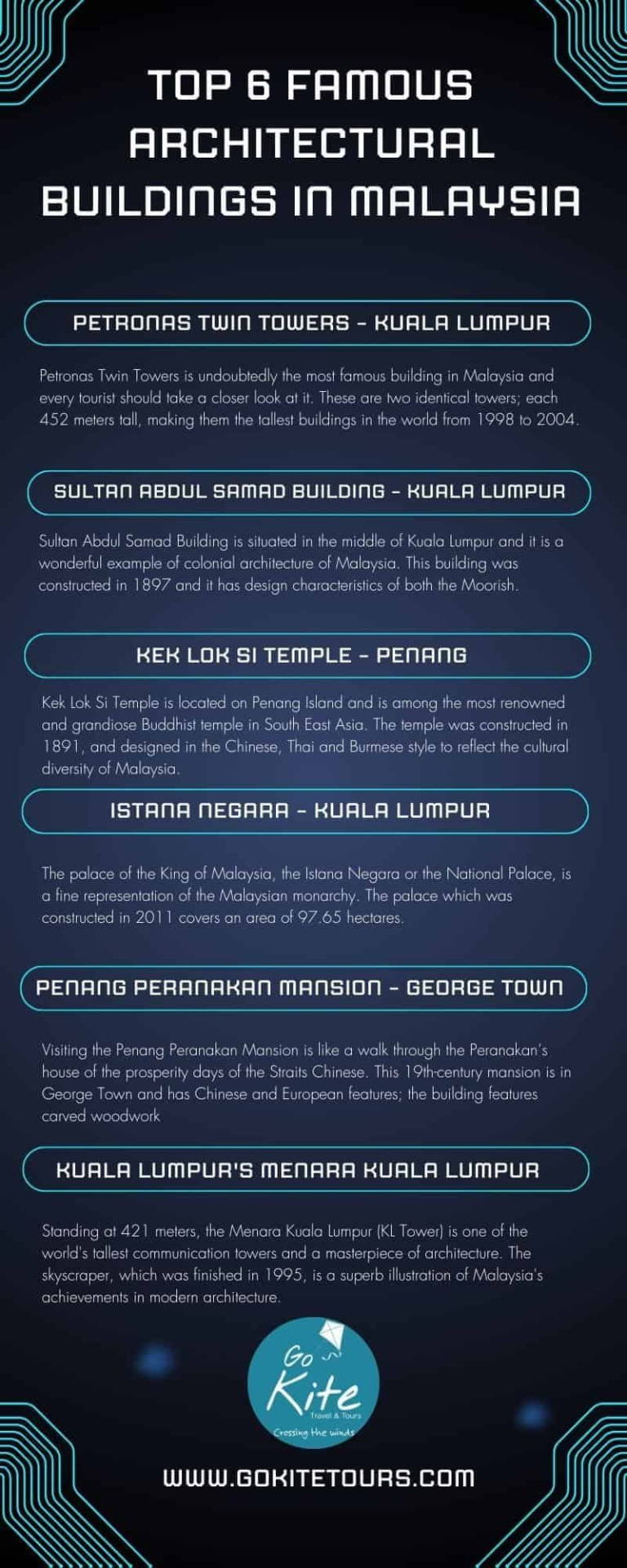
Here is the Top 6 Famous Architectural Buildings in Malaysia
1. Petronas Twin Towers – Kuala Lumpur:
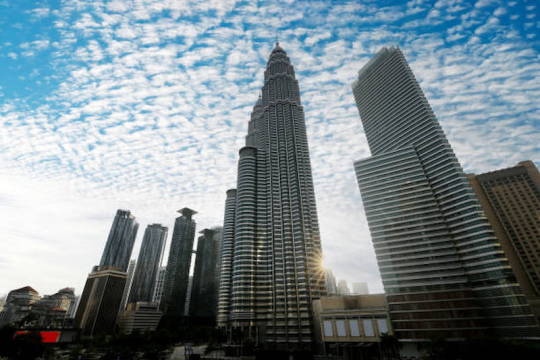
Petronas Twin Towers is undoubtedly the most famous building in Malaysia and every tourist should take a closer look at it. These are two identical towers; each 452 meters tall, making them the tallest buildings in the world from 1998 to 2004. The twin towers were designed by Argentine architect César Pelli and they feature both modern and Islamic art; steel and glass to represent Malaysian technological advancement. Do not leave without crossing the Sky Bridge that links the two towers at the 41st and 42nd floors, where you have a view of Kuala Lumpur.
2. Sultan Abdul Samad Building – Kuala Lumpur
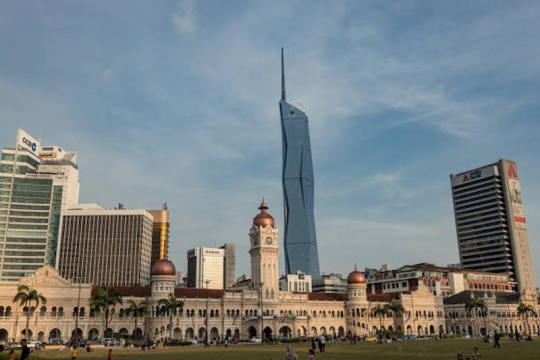
Sultan Abdul Samad Building is situated in the middle of Kuala Lumpur and it is a wonderful example of colonial architecture of Malaysia. This building was constructed in 1897 and it has design characteristics of both the Moorish, Gothic and Western architecture styles. Its clock tower and copper domes are especially prominent and the building is widely photographed, ranking as one of the most photographed in the city. Former British colonial administrative center, it is now home to Malaysia’s Ministry of Information, Communications and Culture.
3. Kek Lok Si Temple – Penang
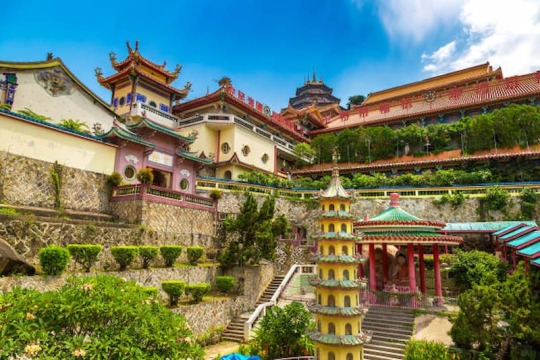
Kek Lok Si Temple is located on Penang Island and is among the most renowned and grandiose Buddhist temple in South East Asia. The temple was constructed in 1891, and designed in the Chinese, Thai and Burmese style to reflect the cultural diversity of Malaysia. One of the major attractions is the seven-tiered Pagoda of Ten Thousand Buddhas which leads to the top of the hill where visitors get to enjoy the breathtaking view of Penang. There are many halls, gardens and shrines inside the temple and all of them depict the architectural features of Buddhist culture.
4. Istana Negara – Kuala Lumpur
The palace of the King of Malaysia, the Istana Negara, or the National Palace, is a fine representation of the Malaysian monarchy. The palace, which was constructed in 2011 covers an area of 97.65 hectares and has architectural elements of Malay and Islamic architecture. With golden domes, large gardens and carved wooden panels, it is an impressive building that represents the majestic Malaysia Royal family. Unfortunately, you can’t actually go into the palace but there is a royal guard march past that resembles the British monarchy.
5. Penang Peranakan Mansion – George Town
Visiting the Penang Peranakan Mansion is like a walk through Peranakan’s house Chinese Stratits. This 19th-century mansion is in George Town and has Chinese and European features; the building features carved woodwork, colorful tiles, and antiques. The building is now a museum, which showcases the Peranakan culture from the exterior and interior architectural designs. It is essential to visit anyone interested in Malaysian cultural heritage.
6. Kuala Lumpur's Menara Kuala Lumpur (KL Tower)
Standing at 421 meters, the Menara Kuala Lumpur (KL Tower) is one of the world's tallest communication towers and a masterpiece of architecture. The skyscraper, which was finished in 1995, is a superb illustration of Malaysia's achievements in modern architecture. Islamic elements are included into the tower's design, signifying the nation's cultural heritage. Take the elevator to the observation deck for sweeping views of Kuala Lumpur, or enjoy a genuinely unique dining experience in the rotating restaurant.
Conclusion:
Malaysia's architectural scene combines creativity, tradition, and history. Every building in Malaysia tells a different tale, whether you're more drawn to the Sultan Abdul Samad Building's rich cultural history or the contemporary Petronas Twin Towers. Not only are these top 6 iconic structures in Malaysia's architectural landscape, Malaysia Visa also serve as windows into the nation's past, present, and future. On your next trip, make sure to explore them and take in Malaysia's architectural marvels.
0 notes
Text
Exploring Malaysia's Rich Historical Sites
Malaysia, a country brimming with cultural diversity and historical significance, offers a treasure trove of ancient landmarks and sites that reflect its vibrant past. From majestic temples to colonial-era buildings, here are ten must-visit historical sites that showcase Malaysia's captivating history.
1. Malacca Historical City
Malacca, a UNESCO World Heritage site, is a testament to Malaysia's colonial past. Explore A Famosa, a Portuguese fortress, and Christ Church Melaka, a Dutch-era church. Don't miss the Malacca Sultanate Palace Museum for insights into the Malay sultanate.
2. Penang Georgetown
Georgetown, Penang's capital, is renowned for its well-preserved colonial architecture. Visit Fort Cornwallis, built by the British East India Company, and the Pinang Peranakan Mansion to delve into the Peranakan culture. Stroll through the UNESCO-listed George Town streets.
3. Batu Caves
Located near Kuala Lumpur, Batu Caves is an iconic Hindu temple complex nestled within limestone caves. Ascend the 272 steps to marvel at the towering statue of Lord Murugan and explore the intricate cave temples.
4. KL Tower
Standing tall in Kuala Lumpur, KL Tower offers panoramic views of the city skyline. Ascend to the observation deck for breathtaking vistas and consider booking KL Tower tickets online for convenient access.
5. Kuching Waterfront
Kuching's waterfront, along the Sarawak River, is a blend of old-world charm and modern attractions. Visit the Fort Margherita, a 19th-century fortress, and the Sarawak Museum to learn about Borneo's diverse indigenous cultures.
6. Sultan Abdul Samad Building
Located in Kuala Lumpur's Merdeka Square, the Sultan Abdul Samad Building is an iconic Moorish-style structure. Admire its grand architecture and historical significance as a former government office during British rule.
7. St. Paul's Hill, Melaka
Climb St. Paul's Hill in Malacca to explore the ruins of St. Paul's Church, originally built by the Portuguese in the 16th century. Enjoy panoramic views of Malacca city and visit the nearby Dutch Graveyard.
8. Islamic Arts Museum Malaysia
Located in Kuala Lumpur, the Islamic Arts Museum Malaysia houses one of the world's most extensive collections of Islamic art. Explore galleries showcasing ceramics, textiles, and calligraphy from across the Islamic world.
9. Sarawak Cultural Village
Experience Sarawak's diverse indigenous cultures at the Sarawak Cultural Village near Kuching. Explore traditional houses and participate in cultural performances to gain insights into Borneo's rich heritage.
10. A'Famosa Fortress
In Malacca, visit A'Famosa Fortress, one of the oldest European architectural remains in Asia. Built by the Portuguese in the early 16th century, it offers a glimpse into Malacca's strategic importance during colonial times.
0 notes
Text
OLD AGE HOME
American houses are as diverse as the country itself, showcasing a blend of history, culture, geography, and architectural styles. From coast to coast, homes in the United States reflect regional influences, evolving tastes, and practical needs of their inhabitants. This article explores the rich tapestry of American housing, highlighting notable styles, trends, and the factors that shape residential architecture across the nation.
Colonial Influence:
The Colonial era profoundly shaped early American architecture, leaving a lasting legacy visible in many parts of the country. Colonial homes, originating primarily from British and Dutch settlers, are characterized by their symmetrical design, steep roofs, and often feature brick or wood exteriors. Variants such as Georgian and Federal styles added refinement and grandeur, particularly in the Northeastern states where wealthy landowners and merchants built imposing mansions.

Victorian Extravaganza:
In the 19th century, the Victorian era brought about an explosion of architectural creativity and ornamentation. Named after Queen Victoria of England, Victorian homes are known for their intricate detailing, steep gabled roofs, and decorative trim work. Substyles like Queen Anne, Second Empire, and Italianate captivated the imagination of builders and homeowners alike, leading to a proliferation of ornate residences across America's cities and suburbs.
The Rise of Suburbia:
The post-World War II era saw a dramatic shift in American housing patterns with the rise of suburbia. Levittown, New York, often cited as the archetype, pioneered mass-produced housing to accommodate returning veterans and their families. Suburban homes typically feature spacious layouts, front yards, and an emphasis on privacy and community living. Ranch-style houses, characterized by their single-story, sprawling design, became synonymous with suburban comfort and convenience.
Mid-Century Modernism:
As the 20th century progressed, mid-century modern architecture emerged as a rejection of ornate Victorian and Colonial styles. Influenced by Bauhaus principles and Scandinavian design, mid-century modern homes emphasize simplicity, functionality, and integration with nature. Flat planes, large windows, and open floor plans define this style, which remains popular for its timeless appeal and seamless indoor-outdoor living.
Regional Diversity:
American housing diversity is further enriched by regional preferences and climatic considerations. In the South, for example, plantation-style homes with wide verandas and large windows offer respite from the heat, while adobe houses in the Southwest reflect Spanish and Native American influences, using thick walls to maintain cool interiors. The Midwest favors sturdy, practical designs like the American Foursquare, characterized by its boxy shape and efficient use of space.
Modern Innovations:
Contemporary American architecture continues to evolve, embracing sustainability, technological advancements, and changing lifestyles. Green building practices promote energy efficiency and environmental responsibility, influencing everything from materials used to design principles. Modern homes often feature smart technology, flexible living spaces, and eco-friendly amenities that cater to a more environmentally conscious generation of homeowners.

Cultural Influences:
Beyond architectural styles, cultural diversity plays a significant role in shaping American homes. Urban areas showcase a mix of historic brownstones, converted lofts, and sleek condominiums reflecting diverse populations and economic trends. In multicultural neighborhoods, homes may blend traditional architectural elements with modern comforts, celebrating heritage while adapting to contemporary living standards.
Future Trends:
Looking ahead, the future of American housing promises to be dynamic and innovative. Trends such as tiny houses cater to minimalist lifestyles and sustainable living, offering affordable housing options in densely populated urban areas. Customizable prefabricated homes allow for quicker construction and greater design flexibility, meeting the demand for personalized living spaces.
Conclusion:
From quaint Cape Cod cottages to sprawling Californian estates, American houses are a testament to creativity, adaptability, and cultural heritage. Each style and trend reflects not only architectural preferences but also societal values, economic conditions, and environmental considerations. As the landscape of American housing continues to evolve, one thing remains certain: the diversity of homes across the United States will continue to inspire, innovate, and define the way Americans live for generations to come.
1 note
·
View note
Text
Saying "I Do" Near London: A Guide to Charming and Unforgettable Wedding Venues

London, a city brimming with history, culture, and undeniable charm, also offers a delightful backdrop for your special day. But with its vast sprawl and diverse neighborhoods, choosing the perfect wedding venue near London can feel overwhelming. Fret not, lovebirds! This guide unveils some of the most enchanting wedding locations near London, catering to a variety of styles, budgets, and guest lists. Fairytale Elegance: Stately Homes and Historic Venues For a touch of timeless grandeur, stately homes and historic venues near London offer a quintessential British wedding experience. Imagine exchanging vows in a grand ballroom adorned with glittering chandeliers, or strolling through manicured gardens hand-in-hand with your new spouse. - Syon Park:Nestled amidst 200 acres of landscaped parkland, Syon Park exudes an air of regal elegance. This grand Palladian mansion boasts a rich history, having been home to the Dukes of Northumberland for over 400 years. Choose from a variety of ceremony locations, including the awe-inspiring Great Hall or the intimate State Rooms. Celebrate with your loved ones in the opulent Conservatory or on the expansive South Lawn, offering picturesque views of the park. - Woburn Abbey:Steeped in history dating back to the 17th century, Woburn Abbey offers a truly unforgettable wedding setting. This magnificent country house boasts grand staterooms, a stunning library, and sprawling grounds. Exchange vows in the opulent Marble Hall or the romantic Garden Room, followed by a reception in the Venetian Dining Room or under a marquee on the Great Lawn. - Hampton Court Palace:Immerse yourselves in history by exchanging vows at Hampton Court Palace, the magnificent former residence of King Henry VIII. Imagine saying "I do" in the stunning Great Hall, followed by a reception in the opulent State Apartments or the picturesque gardens. This iconic venue offers a truly unique and unforgettable wedding experience. Urban Chic: Rooftop Venues and Boutique Hotels London's vibrant energy extends to its wedding venues. For a contemporary and stylish wedding, consider a rooftop venue or a boutique hotel offering stunning cityscapes and a sophisticated ambiance. - The Ned:This iconic landmark, housed in a beautifully restored former Midland Bank building, offers several unique spaces for your wedding celebration. Exchange vows amidst the grandeur of the Banking Hall or the opulent The Saloon, then celebrate with breathtaking city views from the rooftop Ned's Club. - 10-11 Carlton House Terrace:Overlooking the iconic St. James's Park, 10-11 Carlton House Terrace offers a prestigious and elegant setting for your wedding. This Grade II listed building boasts stunning Georgian architecture and a private courtyard ideal for intimate ceremonies. Celebrate with sweeping views of the city skyline from the rooftop terrace. - Dorsett City:For a modern and stylish wedding, consider Dorsett City, a luxurious hotel offering panoramic views of the London skyline. Exchange vows in the light-filled ballroom, followed by a reception on the rooftop terrace showcasing breathtaking cityscapes. This contemporary venue is perfect for couples seeking a chic and sophisticated setting for their special day. Rustic Charm: Countryside Manors and Hidden Gems Escape the hustle and bustle of the city and celebrate your love story amidst the tranquility of the English countryside. Several charming country houses and hidden gem venues located near London offer a rustic and romantic ambience. - Foxtail Barn:Nestled in the picturesque Chiltern Hills, Foxtail Barn is a beautifully converted 18th-century barn offering a rustic yet elegant setting for your wedding. Exchange vows in the light-filled barn, followed by a reception on the landscaped gardens or the charming courtyard. This enchanting venue is perfect for couples seeking an intimate and relaxed wedding celebration. - Petersham Nurseries:For a truly unique and enchanting wedding experience, consider Petersham Nurseries, a haven for nature lovers. Exchange vows amidst the lush greenery of the walled garden, followed by a reception under a marquee or in the charming café. This hidden gem offers a romantic and intimate setting for your special day. - Danesfield House: Steeped in Victorian charm, Danesfield House is a beautiful country house hotel located in the Thames Valley. Hope this guide helps you find your dream destination! Cheers! Read the full article
0 notes
Text
Historic Homes: Tours of Gracie Mansion and Morris-Jumel Mansion
Historic Homes: Tours of Gracie Mansion and Morris-Jumel Mansion http://avrahamglattman.org/historic-homes-tours-of-gracie-mansion-and-morris-jumel-mansion/?utm_source=rss&utm_medium=rss&utm_campaign=historic-homes-tours-of-gracie-mansion-and-morris-jumel-mansion New York City, a bustling metropolis known for its towering skyscrapers and modern marvels, also holds a rich tapestry of history woven into its streets. Two historic homes, Gracie Mansion, and Morris-Jumel Mansion, stand as living testaments to the city’s past, inviting visitors on captivating tours that unveil tales of bygone eras. Gracie Mansion: A Presidential Residence with a Storied Past Gracie Mansion, nestled in the serene Carl Schurz Park on Manhattan’s Upper East Side, is a pristine white mansion that has served as the official residence of New York City’s mayors since 1942. However, its history dates back to 1799 when Archibald Gracie, a prosperous shipping magnate, built the mansion as his country retreat. The mansion has witnessed the ebb and flow of American history, standing as a silent witness to the city’s transformation. Today, visitors can embark on guided tours that navigate through the stately rooms, each echoing with tales of political meetings, social gatherings, and the pulse of the city’s governance. The tour offers a glimpse into the elegant Federal-style architecture, with period-appropriate furnishings that transport visitors to a bygone era. From the grand entrance hall to the formal dining room, the mansion reflects the taste and style of its various occupants over the centuries. One highlight of the Gracie Mansion tour is the art collection, featuring works by renowned artists such as John Singer Sargent and Childe Hassam. The curated pieces enhance the mansion’s aesthetic and narrate a visual history of the city and its vibrant cultural scene. Morris-Jumel Mansion: A Time Capsule in Washington Heights Situated in the picturesque Washington Heights neighborhood, the Morris-Jumel Mansion predates Gracie Mansion, earning the distinction of being Manhattan’s oldest surviving house. Built in 1765 by Roger Morris, a British military officer, the mansion witnessed pivotal moments during the American Revolution, serving as General George Washington’s temporary headquarters in 1776. The mansion changed hands over the years and gained its current name when Stephen Jumel, a wealthy French wine merchant, purchased it in 1810. The Morris-Jumel Mansion tour provides an immersive experience, allowing visitors to step into the past and explore the rooms where history unfolded. As you wander through the opulent chambers, you’ll encounter period-accurate furnishings, exquisite wallpapers, and an impressive collection of artifacts. With its panoramic views of the surrounding landscape, the Octagon Room is a particular highlight, transporting visitors to a time when the mansion was at the center of social and political gatherings. Beyond the historic interiors, the mansion’s gardens offer a serene escape, showcasing meticulously restored 19th-century designs. The Morris-Jumel Mansion’s commitment to preservation and education makes it a must-visit destination for history enthusiasts and anyone eager to connect with the city’s early days. Gracie Mansion and Morris-Jumel Mansion stand as guardians of New York City’s storied past, offering immersive tours that peel back the layers of time. These historic homes provide a unique opportunity to step into the shoes of those who shaped the city and to marvel at the architectural and cultural treasures that have withstood the test of time. Whether you’re a history buff, an architecture enthusiast, or simply curious about the city’s roots, these mansion tours promise an enriching experience that transcends the hustle and bustle of modern-day New York. The post Historic Homes: Tours of Gracie Mansion and Morris-Jumel Mansion first appeared on Avraham Glattman | Fun in NYC.
0 notes
Photo
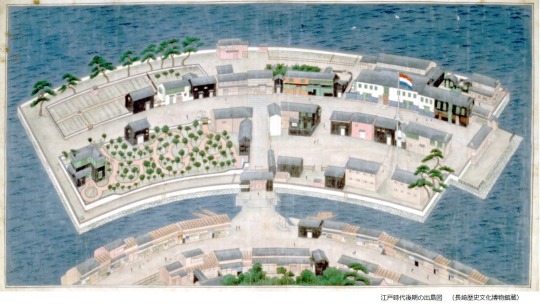
異国情緒と西洋建築 長崎
長崎は長い間、西洋諸国との交流が盛んであり、その影響を受けた異国情緒溢れる景観や洋風建築が特徴です。以下に、長崎の異国情緒と洋風建築に関する詳細を述べます。 1. 出島(でじま): 出島は、江戸時代にオランダ商館が設けられた、人工の島です。長崎港の中心に位置し、当時オランダ人が長崎に滞在していた唯一の場所でした。この島は高い塀で囲まれ、海外からの交易が行われた場所であり、西洋文化が最初に日本に入ってきた場所の一つです。 2. グラバー園: グラバー園は、英国人商人トマス・グラバーが築いた庭園と洋館です。洋風の建物が点在し、バラや樹木が植えられた美しい庭園が特徴です。海外からの情熱的な風情が感じられる場所で、現在は長崎の代表的な観光スポットの一つとなっています。 3. オランダ坂: オランダ坂は、長崎市の中心部にある石畳の坂道で、西洋風の建物やレストラン、カフェが軒を連ねるエリアです。坂道に沿って建てられた洋風の住居や店舗があり、異国情緒を感じさせる雰囲気が漂っています。 4. 洋風建築の教会: 長崎にはキリスト教の歴史的な背景もあり、洋風の教会や聖堂が多く存在します。長崎には長崎大浦天主堂や十六聖人堂など、異国情緒溢れる西洋風の建築物が多く残っています。
♪♫♬🎤🎹🎶♪♫♬🎤🎹🎶♪♫♬🎤🎹🎶♪♫♬🎤🎹🎶
Exoticism and Western architecture Nagasaki
Nagasaki has long had active exchanges with Western countries, and is characterized by its exotic landscape and Western-style architecture. Below, we will provide details about Nagasaki's exotic atmosphere and Western-style architecture. 1. Dejima: Dejima is an artificial island where a Dutch trading post was established during the Edo period. Located in the center of Nagasaki Port, it was the only place where Dutch people stayed in Nagasaki at the time. This island is surrounded by a high wall and is a place where trade from overseas took place, and is one of the places where Western culture first entered Japan. 2. Glover Garden: Glover Garden is a garden and Western-style mansion built by British merchant Thomas Glover. It is dotted with Western-style buildings and features beautiful gardens planted with roses and trees. It is a place where you can feel the passionate atmosphere from overseas, and it is now one of Nagasaki's representative tourist spots. 3. Holland Hill: Orandazaka is a cobblestone slope in the center of Nagasaki City, an area lined with Western-style buildings, restaurants, and cafes. There are Western-style residences and shops built along the slope, giving it an exotic atmosphere. 4. Western-style church: Nagasaki has a historical background of Christianity, and there are many Western-style churches and cathedrals. Nagasaki is home to many exotic Western-style buildings, such as Nagasaki Oura Cathedral and the Hall of the Sixteen Saints.
1 note
·
View note
Text
Affordable Comfort and Convenience: Ginger Hotel - Your Ideal Choice for Budget Hotels in Wakad
Nestled in the western state of Maharashtra, Pune emerges as a vibrant city that seamlessly blends tradition with modernity. As the cultural capital of the region, Pune exudes a unique charm that captivates both locals and visitors alike. With a rich historical legacy, a thriving educational hub, and a vibrant arts and culture scene, Pune stands as a city that offers a delightful tapestry of experiences. Known for its pleasant climate throughout the year, Pune boasts a cosmopolitan ambience coupled with a deep-rooted cultural heritage.
The city's history dates back to the 8th century, with influences from the Maratha Empire, the Peshwas, and the British Raj. This heritage is evident in the architecture, monuments, and forts that dot the cityscape, taking visitors on a captivating journey through time. Pune's educational institutions have earned it the nickname "Oxford of the East," attracting students from all over the country and the world. The presence of prestigious universities, research centres, and colleges has contributed to a vibrant intellectual atmosphere, fostering innovation and learning. Beyond its academic prowess, Pune delights with its thriving arts and culture scene. The city hosts numerous festivals, exhibitions, and performances throughout the year, showcasing a diverse range of music, dance, theatre, and visual arts.
From traditional Maharashtrian folk performances to contemporary art exhibitions, Pune embraces creativity in all its forms. For those seeking culinary adventures, Pune offers a delectable spread of flavours. From street food delicacies to fine dining experiences, the city's gastronomic landscape tantalizes taste buds with a fusion of regional and international cuisines. Pune's lush green spaces, such as parks and gardens, provide a serene escape from the city's hustle and bustle. The city's proximity to the picturesque Western Ghats also offers opportunities for nature enthusiasts to explore hiking trails and enjoy breathtaking views. As you delve into the fabric of Pune, you'll discover a city that gracefully balances tradition and progress. Whether you're exploring its historical landmarks, indulging in its cultural offerings, or savouring its culinary delights, Pune invites you to immerse yourself in its vibrant spirit and create lasting memories. Here is a quick glimpse of the city's major hotspots -
• Shaniwar Wada: Explore the grandeur of this historic fortification, once the seat of the powerful Peshwa rulers of the Maratha Empire.
• Aga Khan Palace: Visit this architectural marvel that holds significant historical importance and houses a museum showcasing Mahatma Gandhi's belongings.
• Dagdusheth Halwai Ganpati Temple: Seek blessings at this renowned temple dedicated to Lord Ganesha, known for its elaborate decorations and vibrant festivities during Ganesh Chaturthi.
• Parvati Hill and Temple: Climb up the hill to reach the Parvati Temple and enjoy panoramic views of the Pune cityscape. It's a popular spot for evening walks and relaxation.
• Raja Dinkar Kelkar Museum: Admire the vast collection of Indian artefacts, sculptures, and handicrafts at this fascinating museum, showcasing the rich cultural heritage of India.
• Pataleshwar Cave Temple: Step into this ancient rock-cut temple dedicated to Lord Shiva, known for its unique architecture and serene ambience.
• Sinhagad Fort: Trek to this historic fort located on a hilltop, offering breathtaking views of the surrounding valleys and a glimpse into Pune's military past.
• Osho Ashram: Experience tranquillity and engage in meditation and spiritual activities at this renowned spiritual centre.
Pune Okayama Friendship Garden: Take a leisurely stroll in this serene garden, featuring Japanese-style landscapes, beautiful flowers, and a peaceful ambience.
Vishrambaug Wada: Discover the architectural splendour of this historic mansion, known for its intricate wooden facades and cultural events. These are just a few highlights of Pune's diverse attractions. As you step foot into Pune, you'll be embraced by an atmosphere that pulsates with creativity and intellectual vigour. The city's vibrant cultural landscape invites you to immerse yourself in its artistic treasures, historical landmarks, and culinary delights, making it a perfect destination for a perfect vacation but in order to fully experience the charm of this beautiful city, it is crucial to find accommodation that balances comfort, accessibility, and affordability. For those seeking budget hotel in Wakad or hotels near railway station in Pune, Ginger Hotel emerges as an excellent choice.
Unveiling Ginger Hotel - The best budget hotel in Wakad near railway station in Pune. Step into Ginger Hotel in Wakad, and you'll immediately feel the perfect blend of contemporary aesthetics and warm hospitality. This remarkable hotel serves as a gateway to Pune's vibrant delights, offering a prime location that bridges the tranquillity of Wakad with the dynamic heart of the city. Get ready to embark on an unforgettable journey as you explore the wonders that lie ahead.
Unparalleled Comfort: At Ginger Hotel, your comfort is our top priority. Experience the luxury of well-appointed rooms adorned with stylish decor, plush bedding, and modern amenities designed to cater to your every need. After a day of adventure, retreat to your cosy haven and allow yourself to be rejuvenated in a peaceful ambience.
Convenient Proximity: Nestled in Wakad, Ginger Hotel offers easy access to Pune's major attractions. Its strategic location near the Pune railway station ensures hassle-free travel to and from the hotel. Immerse yourself in Pune's rich heritage as you explore iconic landmarks such as the majestic Shaniwar Wada, the serene Aga Khan Palace, and the spiritually significant Dagdusheth Halwai Ganpati Temple. With Ginger Hotel as your base, you can indulge in Pune's cultural heritage without wasting precious time on lengthy commutes.
Excellent Connectivity: Staying at Ginger Hotel provides you with unparalleled connectivity, thanks to its proximity to the Pune railway station. Pune's bustling transportation hub offers easy access to local trains, buses, and taxis, ensuring seamless city explorations. Whether you wish to wander through vibrant markets, attend cultural events, or immerse yourself in Pune's vibrant nightlife, Ginger Hotel's convenient location puts it all within your reach.
Affordable Luxury: Ginger is synonymous with affordability without compromising on quality. It offers a range of thoughtfully designed rooms that cater to every traveller's budget, ensuring a comfortable stay at a competitive price. Experience. ional hospitality without straining your finances, allowing you to fully immerse yourself in the wonders of Pune.
Impeccable Services: At Ginger Hotel, your comfort and satisfaction are of paramount importance. The dedicated staff goes above and beyond to provide impeccable services, ensuring that every aspect of your stay is taken care of. From attentive room service to round-the-clock assistance, the team at Ginger Hotel is committed to creating a truly memorable experience the charm of this beautiful city, it is crucial to find accommodation that balances comfort, accessibility, and affordability. For those seeking budget hotel in Wakad or hotels near railway station in Pune, Ginger Hotel emerges as an excellent choice.
0 notes